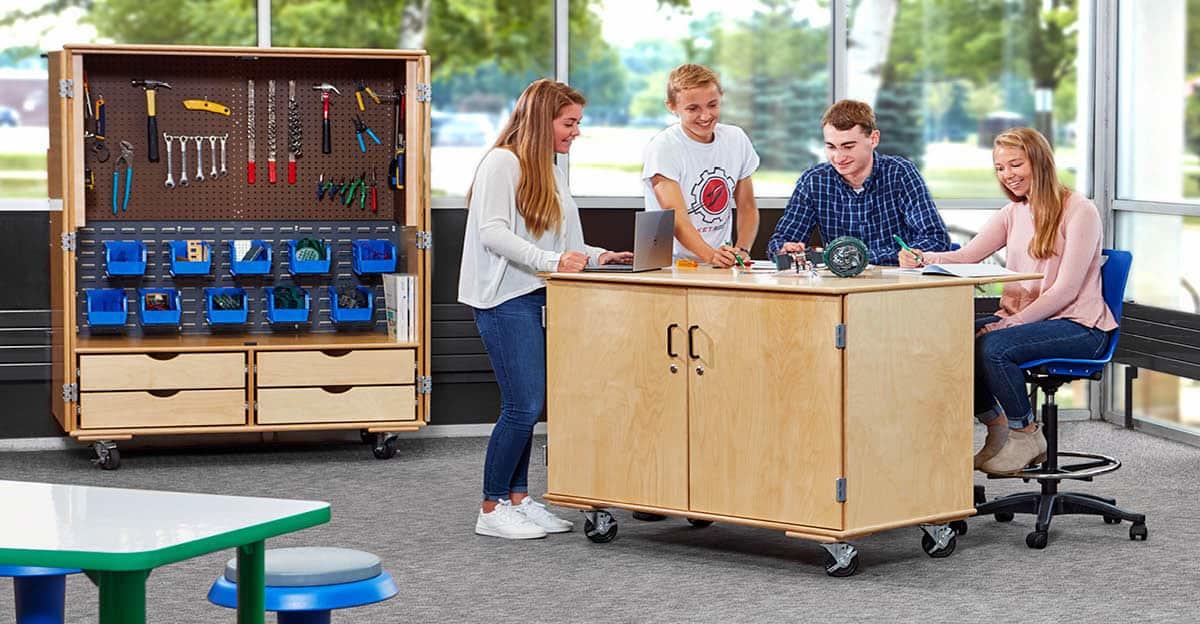The design of the learning space is an important factor in whether collaborative learning succeeds.
For students to work together effectively, they must be sitting in a group and facing each other, so they can interact and exchange ideas freely and easily. Teachers might want to vary the size and composition of student groups depending on the nature of the activity. This means students might be sitting in groups of two or three on some occasions, while at other times they might be sitting in groups of four or five.
When students aren’t working collaboratively, the nature of the instruction might call for a completely different classroom configuration, such as having students face the front of the room for direct instruction.
The key to pulling this off successfully is designing classrooms with flexibility in mind, by creating learning spaces that can be quickly rearranged to support various groupings and activities.
Here are three key design elements that allow for the creation of flexible and agile learning spaces.
Desks and tables that fit together in multiple configurations
Many companies manufacture student desks and tables designed in geometric shapes that fit together easily to create flexible seating arrangements for groups of two, three, four, five, or more students. With these modular furnishings, teachers and students can arrange classroom seating in different ways that best support whatever activity they’re working on—including collaborative learning using multiple group sizes.
Tables and chairs that can be moved around easily
Tables and chairs constructed on sturdy casters can be quickly shuffled around the classroom to create flexible seating arrangements that support student collaboration. With these mobile furnishings, even the youngest students can easily move desks together for collaborative group work and then move them back when they’re finished.
Readily accessible tools for collaboration
As students research topics, brainstorm ideas, generate questions, and complete projects that demonstrate their learning, they need tools to support these collaborative activities. These tools can be as simple as dry-erase surfaces for them to write down their thoughts, or technology-based tools such as digital devices and shared interactive screens.
When you’re designing learning spaces, think about how you’ll make these tools easily accessible to students anywhere in the room. For instance, you can buy classroom desks and tables with dry-erase surfaces for students to write on, or shelving and other furniture with built-in whiteboard surfaces that give students plenty of spaces to record their ideas.
If students will be using digital tools to collaborate, consider buying desks and tables with built-in power supplies and connectivity ports for students to plug in and charge their devices wherever they might be working. Interactive touchscreen displays set up on mobile carts can be wheeled around the room and shared among collaborative groups as needed.
When learning spaces are designed with agility in mind, teachers will be more likely to use collaborative learning as an instructional strategy. If placing students in flexible groupings is too disruptive, takes too much time, or simply isn’t convenient, then educators less likely to go through the hassle—and students will be missing out on a key learning opportunity.
For more collaborative learning advice—including key insights for creating the right kind of learning environment that will enable student collaboration to thrive—download our FREE guide, “The Secrets to Successful Student Collaboration”
Deanna Marie Lock
Deanna Marie Lock is a reputable educational leader with a multifaceted background as an elementary school teacher, assistant principal and principal, Instructional Solutions consultant, Instruction and Intervention Subject Matter Expert, and today as the Director of Category Expertise and Support across all of School Specialty’s target curriculum solutions and widespread product categories. With 18 years spent specifically in the public education sphere, Deanna now uses this in-classroom expertise to add a personalized, intentional approach when professionally advising to an audience she herself had been a part of for nearly two decades. Deanna is passionate about building purposeful long-term internal and external customer connections, and helping students find their passion and highest potential, too!







Leave a Reply